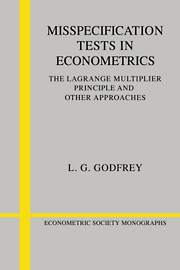Book contents
- Frontmatter
- 1 Approaches to testing the hypothesis of adequate specification
- 2 Inequalities between criteria for testing hypotheses in linear regression models
- 3 The Lagrange multiplier test and testing for misspecification: an extended analysis
- 4 Tests for misspecification of regression equations
- 5 Tests for misspecification of simultaneous equation models
- 6 Tests for qualitative and limited dependent variable models
- Bibliography
- Index
2 - Inequalities between criteria for testing hypotheses in linear regression models
Published online by Cambridge University Press: 05 January 2013
- Frontmatter
- 1 Approaches to testing the hypothesis of adequate specification
- 2 Inequalities between criteria for testing hypotheses in linear regression models
- 3 The Lagrange multiplier test and testing for misspecification: an extended analysis
- 4 Tests for misspecification of regression equations
- 5 Tests for misspecification of simultaneous equation models
- 6 Tests for qualitative and limited dependent variable models
- Bibliography
- Index
Summary
Introduction
Chapter 1 contained an examination of the relationships between the likelihood ratio (LR), Wald (W) and Lagrange multiplier (LM) tests in the context of fairly general statistical models. There is, however, a special case of econometric interest which merits attention because it leads to the systematic numerical inequality
W ≥ LR ≥ LM (1.1)
among the sample values of the test statistics
This remarkable inequality is satisfied when testing linear restrictions on the parameters of a classical regression model with normally distributed errors, and its implications clearly deserve careful consideration. For example, if W, LR and LM are all compared to a common asymptotically valid critical value, then there is the possibility of conflict among the outcomes of the three asymptotically equivalent tests.
This chapter proceeds as follows. In Section 2.2, it is shown that the three classical procedures lead to the same test statistic if the covariance matrix of the disturbances is known. While such knowledge is rarely available, the analysis of this simple case provides a useful stepping stone towards more realistic models and also highlights the effects of having to estimate the parameters of the error covariance matrix. These effects are examined in Section 2.3 and the inequality (1.1) is established, with the case of independent and homoscedastic disturbances being singled out for special comment. The implications of the inequality are discussed in Section 2.4.
- Type
- Chapter
- Information
- Misspecification Tests in EconometricsThe Lagrange Multiplier Principle and Other Approaches, pp. 43 - 68Publisher: Cambridge University PressPrint publication year: 1989



